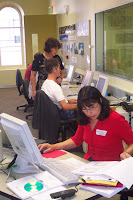
In South Australia since 1996 we have gone through several implementation stages for spatial technology in schools and consider we are in what can be termed the “teacher networking stage”.
The Spatial worlds website
Adelaide: S: 34º 52.846' E: 138º 35.411'
The stages of implementation can be summarised as:
Stage 1: 1996-99: Basic awareness of the motivated: This stage involved groups of highly motivated teachers participating in GIS training provided by the University of Adelaide and University of South Australia under the auspices of the Australasian Urban & Regional Information Systems Association (AURISA). The training purely focussed on training teachers so as to encourage their participation in the AURISA “GIS in Schools” Competition. This training was conducted during the holidays and developed a core group of “true believers” and provided the groundwork for the introduction of GIS into South Australian schools.
Stage 2: 2000-2001: Curriculum involvement: This stage saw the incorporation of GIS into the school curriculum via educational bodies such as the Senior Secondary Assessment Board of South Australia. Such initiatives were very important to give spatial technology credibility and a support base that geographers in schools could use as a “wedge” when requesting training and software. An example of this curriculum support is evident in the following quote from the SSABSA Stage 1 (year 11) curriculum document:
“By using computer technologies, including spatial information systems, students explore and present complicated data in a meaningful way, show relationships and flows between systems, and appraise and report on consequences of decisions made, on geographical and environmental matters. They select, integrate and apply spatial concepts and techniques, using and analysing social and environmental data and information.”
This stage saw the continued training for the AURISA competition but it was only when the new curriculum was launched that the next stage of comprehensive teacher training could be initiated.
Stage 3: Training of teachers by teachers: 2002-5: These years saw over 600 teachers across Australia trained in spatial technology and associated classroom applications under the direction of the Geography Teachers Association of South Australia (GTASA). The involvement of the GTASA and in turn the Australian Geography Teachers Association (AGTA) was very important to bring the area of spatial technology to the attention of teachers. This stage, with the support of the curriculum statements as mentioned, saw geographers convincing their schools to “invest” in spatial technology in the form of buying GIS software, data and participating in available training. The training formats varied from 1-5 days and focussed on the concept of ‘making GIS achievable in the classroom’. The aim of the training was to ensure teachers could go back to their schools and get started in some way using spatial technology in their classroom. Part of this stage involved GIS Roadshows in major centres across Australia which aimed at raising awareness and identifying GIS champions in as many regions as possible. This stage also saw the development of resources and the acquisition of data to support teachers when they went back to their school after attending training. To this end the following resources have been developed by TECHGEOG and the GTASA in South Australia: ‘Making GIS happen in the classroom’, ‘GIS in the Science classroom’, Historical GIS’, ‘Virtual tourism’, ‘GIS in the field’ and ‘Technology in the classroom’. Over 700 schools across Australasia have purchased these products and are using them to support the introduction of spatial technology in their classrooms.
Stage 4: Teacher networking: 2006-7: Having established a relatively large group of “GIS friendly” teachers and implementation ’champions’ across Australia, the process of supporting these teachers and networking was underway and is what we are presently working on. This stage involved the establishment of on-line communities such as the GTASA information newsletters and Meegan Maguire’s Spatial Technology in Schools on-line community in Queensland. An important part of this stage was the ‘ESRI user education Conference’ conducted by AGTA in January, 2006 in Launceston. This event was critical in getting together GIS ‘champions’ and teachers to plan co-operative activities in the future. Throughout this time training has been conducted by the GTASA and in 2007 the GTASA pioneered the CENTRA on-line training with teachers across South Australia. The GTASA has also conducted hub-group training session in regional South Australia throughout 2006 and conducted workshops at all national and state Geography, Science and Computers in education conferences. An initiative of considerable note is the Education Queensland Spatial Technology Expo which has been conducted since 2006. As part of this stage the GTASA has continued to work with curriculum bodies and TAFE to establish overt support for spatial technology in schools. The most significant of these initiatives is the VET Certificate 2 in Spatial Information Systems course which is being delivered in South Australian schools. The GTASA has been given the responsibility to train teachers interested in delivering this VET course in schools. The GTASA considers that much work still needs to be done at the systems level as well as the teacher/school level to ensure that spatial technology is implemented in a coordinated and equitable way in the future. The GTASA under the auspices of AGTA has also been working with the spatial industry by being an active member of the Spatial Science Institute Education Advisory Committee in Canberra.
Hopefully this spatialworlds project will give us some ideas about what works, what does not work and where to next with the implementation of spatial technology in schools. Maybe the next stage is:
Stage 5: System support in staffing and monetary terms’: 2008- ?
No comments:
Post a Comment